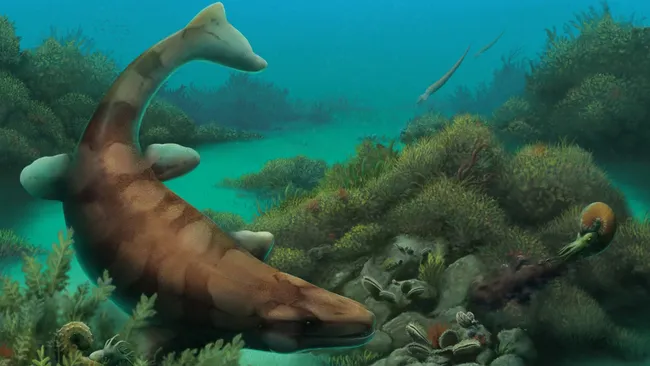A new study has found fossils of a huge, rare mosasaur with giant globular teeth in Texas. Two pieces of an adult’s jaw provide insight into its lifestyle. Globidens alabamaensisIt could reach lengths of 20 feet (6 meters), and the blunt teeth lining the jaws indicate the brute force mosasaurs exerted on their prey.
“With their mushroom-like shape, these structures are great for shock attacks, that is, for breaking shells. “If something escapes and you break it, it’s gone,” marine paleontologist and faculty member at the Texas Through Time Fossil Museum in Hillsboro, Bethany Burke Franklin, told LiveScience. Franklin, an expert on marine reptiles, was not involved in the research.
During the Late Cretaceous (100.5 million to 66 million years ago), many iconic marine predators, such as dolphin-like ichthyosaurs and long-necked plesiosaurs, succumbed to climate change and the resulting changes in the marine ecosystem. Mosasaurs became dominant predators in the shallow seas of the period, occupying the niches once occupied by their better-known ancestors. These reptiles diversified rapidly, filling many gaps in an unstable and prey-rich environment.
G. alabamaensis It was discovered in 1912, but only a few nearly complete specimens of this mosasaur have been found. Most of the fossil evidence consists of teeth and small jaw fragments. Four more species have been described since then Globiden.
Although most mosasaurs had formidable dagger-like teeth, Globiden they developed blunt, rounded teeth suitable for breaking the shells of turtles, ammonites, and bivalves. The Western Interior Seaway, which divided the modern landmass of North America during the Late Cretaceous, G. alabamaensis a wide variety of armored prey.
The researchers described the discovery of the two jawbones in a paper published Aug. 14 in the Journal of Paleontological Sciences. The fragments were discovered in 2023 by a dedicated fossil hunter in the Ozan Formation in northeastern Texas. The beds they were found in date from the Campanian period (83.6 to 72.1 million years ago) and are only 20 centimeters thick, but have proven rich in fossils, including those of other mosasaurs.
Franklin said it’s a blessing to see even part of an animal’s head preserved. “The skull material tends to be more compressible, especially in those thin layers,” he explained.
One jaw still has 12 teeth; another has retained only six. The teeth are about an inch long and rounded, perfectly designed for cracking hard mollusk shells. In one jaw, a baby tooth remains below the gum line. It seems likely that it would later fill the gap. Scientists believe that mosasaurs, like sharks, shed their teeth and gained new ones throughout their lives.
These unique teeth allowed them to coexist with other large mosasaurs as they pursued different types of prey, Franklin said.
“The adaptation was probably influenced by the abundance of cephalopods,” he explained. “Many species were able to coexist because they did not occupy the same resources. They [мозазаври] “They were among the fastest-evolving predators of the time. They filled niches left by other large marine predators; there were huge gaps in the food web”.
Source: Port Altele
